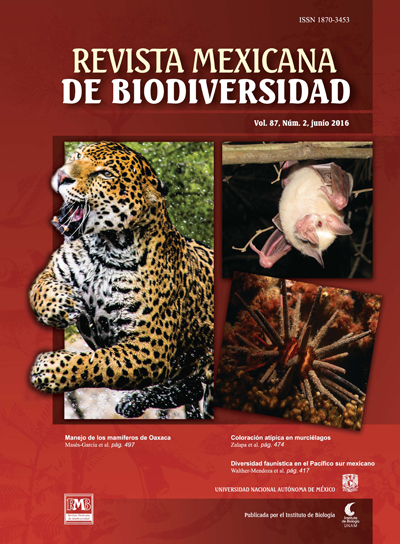The caridean shrimps (Crustacea: Decapoda: Caridea: Alpheoidea, Palaemonoidea, and Processoidea) from Bahía Chamela, Mexico
DOI:
https://doi.org/10.1016/j.rmb.2016.04.002Palabras clave:
New records, Jalisco, Tropical Mexican Pacific, BiodiversityResumen
During a faunistic survey of the islands and islets of Bahía Chamela, Jalisco, Mexico, 40 species of caridean shrimps belonging to 5 families were collected; the Alpheidae with 3 genera and 20 species was the best represented, followed by the Palaemonidae with 10 genera and 12 species. Other families found were: Hippolytidae (3 genera, 5 species), Gnathophyllidae (1 genus, 1 species), and Processidae (1 genus, 2 species). Compared with the rest of the Mexican Pacific, the number of species found represents 44% of the genera and 45% of the benthic species of caridean shrimps reported to date. Ninety percent of the species collected correspond to new records for Bahía Chamela. Two species, Neopontonides henrivronprahli from Costa Rica and Colombia, and Thor cocoensis from Costa Rica and the Galápagos Islands, are recorded for the first time since their original description, extending their distribution range by ca 16 and 14 degrees of latitude to the north, respectively.Citas
Abele, L.G. 1975. The macruran decapod Crustacea of Malpelo Island. Smithsonian Contributions to Zoology 176: 69-85.
Abele, L.G. 1976. Comparative species composition and relative abundance of decapod crustaceans in marine habitats of Panama. Marine Biology 38: 263-275.
Ahyong, S.T., J.K. Lowry, M. Alonso, R.N., Bamber, G.A. Boxshall, P. Castro, S. Gerken, G.S. Karaman, J.W. Goy, D.S. Jones, K. Meland, D.C. Rogers and J. Svavarsson. 2011. Subphylum Crustacea Brünnich, 1772. In: Animal biodiversity: An outline of higher-level classification and survey of taxonomic richness, Z.-Q. Zhang, (ed.) Monograp, Zootaxa, 3148: 1-237.
Álvarez, F., M.E. Camacho and J.L. Villalobos. 1996. The first species of Prionalpheus from the eastern Pacific, and new records of caridean shrimp (Crustacea: Decapoda: Caridea) from the western coast of Mexico. Proceedings of the Biological Society of Washington, 109(4): 715-724.
Álvarez del Castillo, C.M., M. Hendrickx, and S.C. Rodríguez. 1992. Crustáceos decápodos de la laguna Barra de Navidad, Jalisco, México. Proceedings of the San Diego Society of Natural History, 27: 1-9.
Anker, A., S.T. Ahyong, P.Y. Noël and A.R Palmer. 2006. Morphological phylogeny of alpheid shrimps: Parallel preadaptation and the origin of a key morphological innovation, the snapping claw. Evolution, 60: 2507-2528.
Anker, A., C. Hurt and N. Knowlton. 2007. Revision of the Alpheus nuttingi (Schmitt) species complex (Crustacea : Decapoda : Alpheidae), with description of a new species from the tropical eastern Pacific. Zootaxa, 1577, 41-60.
Anker, A., C. Hurt, J. Jara and N. Knowlton. 2008a. Revision of the Alpheus cylindricus Kingsley, 1878 species complex (Crustacea: Decapoda: Alpheidae), with revalidation of A. vanderbilti Boone, 1930. Zootaxa, 1943: 53-68.
Anker, A., C. Hurt and N. Knowlton. 2008b. Revision of the Alpheus cristulifrons species complex (Crustacea: Decapoda: Alpheidae), with description of a new species from the tropical eastern Atlantic. Journal of the Marine Biological Association of the United Kingdow, 88(3): 543-562.
Anker, A., C. Hurt and N. Knowlton. 2008c. Revision of the Alpheus websteri Kingsley, 1880 species complex (Crustacea: Decapoda: Alpheidae), with revalidation of A. arenensis (Chace, 1937). Zootaxa, 1694: 51-68.
Anker, A. and P.P.G. Pachelle 2013. Re-examination of the eastern Pacific and Atlantic material of Alpheus malleator Dana, 1852, with the description of Alpheus wonkimi sp. nov. (Crustacea, Decapoda, Alpheidae). Zootaxa, 3637(4): 412-431.
Arzola-González, J.F., L.M. Flores-Campaña and A. Vázquez-Cervantes. 2010. Crustáceos decápodos intermareales de las islas de la costa de Sinaloa, México. Universidad y Ciencia, 26(2): 179-193.
Ayón-Parente, M., M.E. Hendrickx and E. Ríos-Jara. 2012. Notes on two species of Processa (Decapoda: Processidae) from the Mexican Pacific. Nauplius, 20(1): 63-73.




